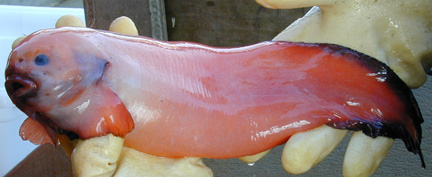- Snailfish
Taxobox
name = Snailfishes

image_caption = Snailfish (probably "Elassodiscus tremebundus ") caught in the eastern Bering Sea
regnum =Animal ia
phylum = Chordata
classis =Actinopterygii
ordo =Scorpaeniformes
familia = Liparidae
subdivision_ranks = Genera
subdivision = "Acantholiparis "
"Allocareproctus "
"Careproctus "
"Crystallichthys "
"Edentoliparis "
"Elassodiscus "
"Genioliparis "
"Gyrinichthys "
"Liparis"
"Lipariscus "
"Menziesichthys "
"Nectoliparis "
"Notoliparis "
"Odontoliparis "
"Osteodiscus "
"Palmoliparis "
"Paraliparis "
"Polypera simushirae "
"Psednos "
"Pseudoliparis"
"Rhinoliparis "
"Rhodichthys "
"Squaloliparis "Snailfishes are scorpaeniform marine
fish of the family Liparidae. Widely distributed from the Arctic toAntarctic Ocean s including the northern Pacific, the snailfish family contains approximately 23 genera and 195 species. They are closely related to thesculpin s of the Cottidae family and thelumpfish of the Cyclopteridae family. Snailfish are sometimes included within the latter family.The snailfish family is poorly studied and few specifics are known. Their elongate,
tadpole -like bodies are similar in profile to therattail s. Their heads are large with small eyes; their bodies are slender to deep, tapering to a very small tail. The extensive dorsal and anal fins may merge or nearly merge with the tail fin. Snailfish are scaleless with a thin, loose gelatinous skin; some species, such as thespiny snailfish ("Acantholiparis opercularis") have prickly spines as well. Their teeth are small and simple with blunt cusps. The deep-sea species have prominent, well-developed sensorypore s of the head, part of the animals'lateral line system.The pectoral fins are large and provide the snailfish with its primary means of locomotion. They are
benthic fish with pelvic fins modified to form an adhesive disc; this nearly circular disc is absent in "Paraliparis" and "Nectoliparis" species. Snailfish range in size from "Paraliparis australis" at 5 centimetres to "Polypera simushirae" at some 77 centimetres in length. The latter species may reach a weight of 11 kilograms, but most species are toward the smaller end of this range. Snailfish are of no interest to commercial fisheries.The habitats chosen by snailfish are as widely variable as their size; they are found in both shallow intertidal zones and at fantastic depths of 7,500 metres or more, in both cold and warm waters. The diminutive
inquiline snailfish ("Liparis inquilinus") of the northwestern Atlantic is known to live out its life inside the mantle cavity of thescallop "Placopecten magellanicus". Thekelp snailfish ("Liparis tunicatus") lives amongst thekelp forests of theBering Strait and theestuary of theSt. Lawrence River . Other species are found on muddy or silty bottoms ofcontinental slope s. Snailfish are abundant in most (especially polar) waters and are highly resilient.Reproductive strategies are also known to vary among the species. At least one species, the
abyssal snailfish (Careproctus ovigerum) of the North Pacific, is known to practicemouth brooding ; that is, the male of the species carries the developing eggs around in his mouth. All species are known to lay a small number (c. 300) of relatively large eggs (4.5-8 mm in diameter). Other species of the genusCareproctus lay their eggs in the gill cavities ofking crab s.The diet of snailfish consists primarily of small benthic
crustacean s,mollusk s,polychaete worms, and other smallinvertebrate s. Some species are alsopiscivorous . Specialist species such as "Paraliparis rosaceus" feed exclusively onsea cucumber s.In October 2008, a UK-Japan team discovered a shoal of "
Pseudoliparis amblystomopsis " at a depth of 7.7km (4.8 miles) in theJapan Trench , these are believed to be the deepest living fish ever recorded [http://news.bbc.co.uk/1/hi/sci/tech/7655358.stm] .References
*
External links
Wikimedia Foundation. 2010.
